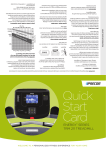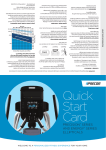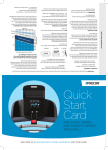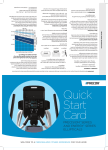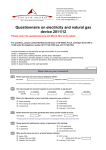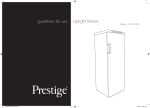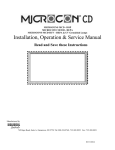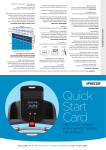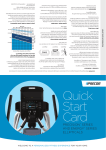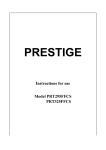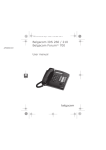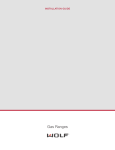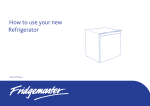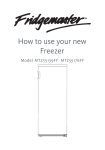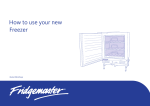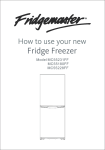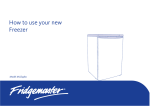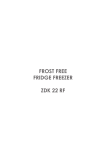Download Hisense MCF145 freezer
Transcript
This symbol on the product or in the instructions means that your electrical and electronic equipment should be disposed at the end of its life separately from your household waste. There are separate collection systems for recycling in the EU. For more information, please contact the local authority or your retailer where you purchased the product. How to use your new Chest Freezer Model MCF98 - MCF145 - MCF205 2 GETTINGTO TOKNOW KNOWYOUR YOURCHEST CHEST FREEZER FREEZER GETTING Location Before use Please read all instructions carefully before using your new Fridgemaster Chest Freezer. For indoor and domestic use only. Please keep these instructions in a safe place for future reference. FREEZER CHEST LID and the room is well ventilated with an average room temperature of between 16ºC and 32ºC. Avoid locating your Chest Freezer near a heat source, e.g. cooker, boiler or radiator. Also avoid direct sunlight. If you are placing your Freezer in a outer building such as a garage or annex ensure that the Chest Freezer is placed above the damp course, otherwise condensation will occur on the Chest Freezer cabinet. When your Chest Freezer is working the sides will become warm. It must therefore be installed so that there is 10cm of free space at the back of the Chest Freezer and 5cm at the sides. Do not drape the Freezer with any covering . Levelling the Freezer Make sure the Freezer is level. If the Freezer is not level, the lid and . Cleaning before use Wipe the inside of the Chest Freezer with a weak solution of bicarbonate of soda. Then rinse with warm water using a ‘wrung-out’ sponge or cloth. Wipe completely dry before replacing the basket. You could clean the Freezer externally with wax polish. If you require more information refer to ‘Cleaning inside the Freezer’ on page 6. Before plugging in YOU MUST Check that you have a socket which is compatible with the plug supplied with the Chest Freezer. If not, see the section called ELECTRICAL CONNECTIONS on page 8 CONTROL PANEL POWER ON LIGHT Before switching on! DO NOT SWITCH ON UNTIL TWO HOURS AFTER MOVING THE FREEZER. The coolant needs time to settle. We recommended you read the section called SAFETY on pages 9. Before using your Freezer Before placing frozen foods in your Chest Freezer, turn the Freezer on and wait for 24 hours, to make sure it is working properly and to allow the Freezer to fall to the correct temperature. Your Freezer should not be BASKET Freezer Basket The Basket is designed to be placed inside the Freezer. 3 USING USINGYOUR YOURCHEST CHESTFREEZER FREEZER Operating instructions Switching on your Freezer 1 As soon as the Freezer is plugged in the Orange power light, on the control panel, will glow. 2 Allow 24 hours for the Chest Freezer to reach the set temperature, see adjusting the temperature. Adjusting the temperature The internal temperature of your appliance is controlled by a Thermostat. Max position makes the apppliance colder and it ‘ s used for fast freezing The recommended position is between MID but should be adjusted according to its environment. The appliance may not operate correctly if it is in a particularly hot or cold room or if the lid is opened often or for prolonged periods. Noises inside the Freezer! If you have not owned a freezer before, you may notice that it makes some rather unusual noises. Most of these are perfectly normal, but you should be aware of them! GURGLING, WHOOSHING These noises are caused by the circulation of the refrigerant liquid in the cooling system. It has become more pronounced since the introduction of CFC free gases. This is not a fault and will not affect the performance of your freezer HUMMING, PURRING OR PULSATING This is the compressor motor working, as it pumps the refrigerant around the system. Is the Freezer cold enough? A few days after you start using your Freezer you may wish to check that it is running at the correct temperature. You will need a special Freezer thermometer available from most supermarkets and hardware shops. The temperature should be -18˚C or lower. Indicator Lights ORANGE - MAINS POWER ON This light glows continually when electricity is being supplied to the Freezer. If the light goes out, check: • That the plug has not been removed accidentally. • That the switch on the electricity socket is turned on. • That the fuse in the plug has not blown. Try another household appliance, such as a lamp, in the socket. If all the above are in order, the or ange lamp bulb may have blown. Call your Customer Service Department if this is the case. 4 USING YOUR CHEST FREEZER Shopping for frozen foods To Thaw Your Freezer is 4 star 1 Cover food loosely. When you are buying frozen food, look at the Storage Guidelines on the packaging. You will be able to store each item of frozen food for the period shown against the 4 star rating. This is usually the period stated as ‘Best Before’, on the front of the packaging. Check the freezer temperature Check the temperature of the frozen food cabinet in the shop where you buy your frozen foods. It should show a temperature lower than -18°C. Choose packs carefully Take a quick look at the frozen food package and make sure it is in perfect condition. Purchase frozen food last Always buy frozen products last on your shopping trip or visit to the supermarket. Keep frozen foods together When you are going around the supermarket and when you are travelling home, if you keep all the frozen foods together they will help to keep each other cold. 2 Thaw at room temperature. Don’t forget that thawing in a warm area encourages the growth of bacteria. 3 Always make sure there are no ice crystals in the food before cooking, particularly with meat. These crystals indicate that the food is not fully thawed. They result in lower temperatures when cooking. Lower cooking temperatures may not destroy dangerous bacteria. 4 Cook food as soon as possible after thawing. 5 Drain off and throw away any liquid lost during thawing. Oven Thawing Many microwaves and ovens have thaw settings. To avoid bacterial build up, only use these if you intend to cook the food immediately afterwards. Safety Tips • Never re-freeze anything that has thawed out unless you cook it again, to kill off harmful bacteria. • Never re-freeze thawed shellfish. Useful Tips • Re-seal packs properly after removing items. This prevents drying or ‘freezer burn’ and a build up of frost on any remaining food. Freezing Fresh Foods Useful tips Use quality food and handle it as little as possible. Freeze food in small quantities, it freezes faster, takes less time to thaw and enables you to eat it in the quantity you need. When freezing fresh foods do not place them in contact with already frozen foods. Freezing fresh foods First, estimate the amount of food you will be freezing. Turn the thermostat to Max. It will therefore freeze quicker and keep in the goodness. However you should use it sparingly to conserve energy. TO FREEZE A loaf of bread A small casserole MAX SETTING not required MODELL MCF98 MAX IMUM OF 9.5KG 24 hrs. before placing food in freezer and 24 hrs. after placing food in freezer. MODELL MCF145 MAX IMUM OF 13KG MODELL MCF205 MAX IMUM OF 15KG 24 hrs.before placing food in freezer and 24 hrs. after placing food in freezer. 24 hrs.before placing food in freezer and 24 hrs. after placing food in freezer Store food straight away What not to Freeze Don’t buy frozen food unless you can freeze it straight away. Special insulated bags can be bought from most supermarkets and hardware shops. These keep frozen food cold for longer. Bananas, Pomegranates or Pears. Carbonated liquids should never be frozen. Thawing frozen food For some foods, thawing before cooking is unnecessary. Vegetables and pasta can be added directly to boiling water or steam cooked. Frozen sauces and soups can be put into a saucepan and heated gently until thawed. 5 USING YOUR CHEST FREEZER Preparations for freezing • • • • Leave cooked food to cool completely. Chill food in a fridge before freezing if possible. Consider how you want to cook the food before freezing it. Don’t freeze food in metal containers if you may want to microwave it straight from the Freezer. • polythene bags, plastic containers, aluminium foil (heavy grade only, if in doubt, double wrap). Don’t use aluminium foil for acidic foods (such as citrus fruits) Don’t • • • Exclude as much air from the container as possible. You could buy a special vacuum pump which sucks excessive air out of the packaging. Leave a small amount of ‘air space’ when freezing liquids, to allow for expansion. You can use the space in the freezer most with liquids, such as stew) in square blocks. This is known as ‘preforming’. Pour the liquid into a polythene bag which is inside a square sided container. Freeze it like this, then remove it from the container and seal the bag. Label everything • Many foods look the same when frozen, so careful labelling will help avoid forgetting what an item is. Storage times being exceeded could cause food poisoning. • You can buy special freezer tape for use in low temperatures. This tape is available in white, so you can use it to write the items contents on. You can buy special freezer labels and pens. Labels vegetables green. • Write the contents and date. If you are really organised add the weight and notes on cooking such what is in each drawer. This will save opening the lid and searching around unnecessarily. Recommended Storage Periods Fruit Syrup or Sugar packed Fruit Open Frozen or Puréed Fruit Fruit juices (when frozen from fresh) up to 12 months up to 18 months up to 6 months Beef up to 12 months Lamb up to 9 months Veal up to 6 months Pork up to 6 months Minced meat up to 3 months Cured meats up to 2 months Sausages up to 3 months Packed bacon up to 3 months Smoked bacon/ chops/ gammon steaks up to 2 months Unsmoked bacon/ chops/ gammon steaks up to 1 month Chicken up to 12 months Duck up to 5 months Goose up to 5 months Turkey up to 6 months up to 3 months up to 2 months Smoked salmon Caviar up to 3 months don’t freeze up to 1 month Butter up to 6 months Cheese up to 9 months Cream - double/ whipping up to 3 months Eggs - only freeze separated up to 6 months Suet up to 6 months Milk up to 1 month Yogurt up to 6 weeks 6 MAINTENANCE Defrosting Cleaning inside the Freezer After a period of time frost will build up in certain areas, for example, on the sides and just below the lid. As a temporary measure, this frost should be scraped aw ay using a plastic scraper. NEVER use metal or sharp instruments. and remove the Move existing foods to one side of the cabinet, scrape frost, then move your foods back in order to gain a ccess to the other side. Complete defrosting will however, become necessary, approximately twice per year, or if the frost layer exceeds 2-5cm (1-2”) to maintain the efficiency of the Freezer. Excessive frost build up results in increased running times and costly energy consumption. This should be carried out if the frost build up cannot be scraped away, or if it begins to interfere with the food storage. Choose a time when the You should clean the Freezer internally with a weak solution of bicarbonate of soda. Then rinse with warm water using a ‘wrung-out’ sponge or cloth. Wipe the Freezer dry before replacing the basket. stock of frozen food is low and proceed as follows: 1 Take out the frozen food, turn the Freezer off at the mains supply and leave the lid open. Ideally the fr ozen food should be put into another Freezer or refrigerator. If this is not possible wrap the food, firstly in several sheets of newspaper or large towels and then a thick rug or blanket and keep it in a cool place. 2 Scrape away as much frost buildup as possible using a plastic scraper. Thawing of the remainder can be speeded up by placing bowls of hot water inside the cabinet and closing the lid. As the solid frost loosens, prize it away with a plastic scraper. 3 When defrosting is completed,clean your Chest Freezer as described in ‘Cleaning inside the Freezer’ Cleaning the outside of the Freezer Use standard furniture polish to clean the Freezer exterior. Make sure that the Lid is closed, to prevent polish getting on the magnetic lid seal or inside. The grille of the condenser at the back of the Freezer and the adjacent components can be vacuumed using a soft brush attachment. Troubleshooting Power cut If you have a freezer thermometer, place it in the Freezer where you can get easy access to it to read when the power returns. If the internal temperature is -18°C or less when the power returns, your food is safe. The food in your Freezer will remain frozen for approx 12 hours with the lid closed. If you know the power is going to be cut, turn the thermostat to MAX 24 hours before, this will make the Freezer colder than normal. If there is no warning, turn the thermostat to MAX after the power cut. Don’t open the lid more than necessary. The Freezer is particularly cold You may have accidentally turned the thermostat to Max . The Freezer is particularly warm The compressor may not be working. Turn the thermostat to Max . If there is no humming noise, it is not working. Call your Customer Service Department. The Freezer is not working Check it is plugged in and switched on. Check that the fuse in the plug has not blown. Plug in another appliance, such as a lamp, to see if the socket is working. Condensation appears on the outside of the Freezer This may be due to a change in the room temperature or by being placed in a location without a dampcourse. Wipe off any residue of moisture. If the problem continues call your Customer Service Department. 7 TECHNICAL SPECIFICATIONS MAINTENANCE Moving your Freezer Location Do not locate your Freezer near a heat source, eg. cooker, boiler or radiator. Also avoid direct sunlight . Levelling the Freezer Make sure the Freezer is level. If the Freezer is not level, the lid and magnetic seal alignments will be Do not turn on the Freezer for 2 Hours After the Freezer is in place it needs to be left for 2 hours. The coolant Installation Warning - do not cover or block vents or grilles of your appliance. Servicing Repairs and maintenance of the appliance should only be performed by an authorised technician Model MCF98 MCF145 MCF208 Rated Voltage (V) 220-240 220-240 Rated Frequency (Hz) 50 50 50 99 3.50 146 5.16 206 7.28 Gross Volume (Litres) (Cubic Feet) Freezing Capacity (kg/24 Hours) 9.5 Star Rating 4 Star Weight (kg) 27 Product Dimension h/w/d (cm) Sound Decibel Rating (dB[A] Refrigerant 13 4Star 31 83.6/56.3/52.6 82.5/72.6/56.2 45 R600a 220-240 15 4 Star 36 83.0/94.6/57.6 45 45 R600a R600a The policy of Fridgemaster is one of continuously seeking new ways of improving its products. Therefore the Company reserves the right to change the specification of items illustrated and described, at any time. 8 ELECTRICAL CONNECTIONS Disposal Old appliances still have some residual value. An environmentally friendly method of disposal will ensure that valuable raw materials can be recovered and used again. The refrigerant used in your appliance and insulation materials require special disposal procedures. Ensure that none of the pipes on the back of the appliance are damaged prior to disposal. Up to date information concerning options for disposing of your old appliance and packaging from the new one can be obtained from your If the colours of the wires in the mains lead of this appliance do not correspond with the coloured markings identifying the terminals in your plug, proceed as follows: The wire which is coloured Green and Yellow MUST be connected to the terminal which is marked with the letter E (Earth) or symbol coloured Green. The wire which is coloured Blue MUST be connected to the terminal which is marked with the letter N or coloured Black. The wire which is coloured Brown MUST be connected to the terminal which is marked with the letter L or coloured Red. Locks entrapped keep the key out of reach and not in the vicinity of the appliance. wire inside the plug. Use a 13 Amp BS1362 fuse, only BSI or ASTA approved fuses should be used. If you are in any way unsure which plug or fuse to use, always refer to a as a safeguard. THIS APPLIANCE MUST BE EARTHED. Note: After replacing or changing a fuse on a moulded plug which has a fuse must not be used without a fuse cover. If lost, replacement fuse covers can be obtained from an electrical shop. and carefully disposed of. To avoid a possible shock hazard, do not insert the discarded plug into a socket . Fitting a new plug If for any reason you need to a new plug, The Mains Lead must be c onnected as shown here. with the following code: CONNECT BLUE TO NEUTRAL (N) CONNECT GREEN AND YELLOW TO EARTH (E) (Note: some app liances do not have earth wires.) CONNECT BROWN TO LIVE (L) MAKE SURE THE CABLE IS HELD BY THE CLAMP This appliance complies with the following EEC Directives: 73 / 23 EEC (Low VoltageDirective) 89 / 336 EEC (EMC Directive). 9 SAFETY Locks If your refrigerator is fitted with a lock, to prevent children being entrapped keep the key out of reach and not in the vicinity of the appliance. If disposing of an old refrigerator, break off any old locks or latches as a safeguard. The appliance was designed and manufactured in compliance with international safety standards. The following warnings are provided for safety reasons and must be read carefully. WARNING IT IS HAZARDOUS FOR ANYONE OTHER THAN AUTHORISED SERVICE PERSONNEL TO CARRY OUT SERVICING OR REPAIRS WHICH INVOLVE THE REMOVAL OF COVERS. TO AVOID THE RISK OF AN ELECTRIC SHOCK DO NOT ATTEMPT REPAIRS YOURSELF. This appliance complies with the following Community Directives: - 73/23/EEC of 19/02/73 (Low Voltage) and subsequent amendments; - 89/336/EEC of 03/05/89 (Electromagnetic Compatibility) and subsequent amendments; - 2002/96/CE. Information concerning disposal Disposal of your old appliance Old appliances are not worthless rubbish! Recycling old appliances can reclaim valuable raw materials. This appliance has been identified in accordance with the European directive 2002/96/EC on Waste Electrical and Electronic Equipment – WEEE. The directive requires that old household electronic appliances must not be disposed of in the normal unsorted municipal waste stream. Old appliances must be collected separately in order to optimise the recovery and recycling of the materials they contain and reduce the impact on human health and the environment. The crossed out “wheeled bin” symbol on the product reminds you of your obligation, that when you dispose of the appliance it must be separately collected. Consumers may take their old appliances to public waste collection areas, other communal collection areas, or if national legislation allows return it to a retailer when purchasing a similar new product. Disposal of packaging Old appliances still have some residual value. An environmentally friendly method of disposal will ensure that valuable raw materials can be The packaging protects your appliance from damage during recovered and used again. The refrigerant used in your appliance and transit. Please contribute to a better environment by disposing of insulation materials require special disposal procedures. Ensure that none the packaging materials in an environmentally friendly manner. of the pipes on the back of the appliance are damaged prior to disposal. Up to date information concerning options for disposing of your old Observe local environmental standards when disposing of packaging appliance and packaging from the new one can be obtained from your material for recycling purposes. local council office. Please ask your dealer or inquire at your local authority about current means of disposal. Redundant appliances: Keep packaging materials out of the reach of children! It can become a choking or suffocation hazard. Cut off the mains plug and discard it. Refrigerators contain refrigerants and the insulation contains gases. Refrigerant and gases must be disposed of properly. Ensure the tubing of the refrigerant circuit is not damaged prior to proper disposal. 10 SAFETY Safety and warning information Important information when using the appliance Before you switch ON the appliance • This appliance is not intended for use by persons (including children) with reduced physical, sensory or mental capabilities, or experience or knowledge, unless they have been given supervision or instructions concerning the use of the appliance by a person responsible for their safety. Children should be supervised to ensure that they do not play with the appliance. • If the supply cord is damaged, it must be replaced by the manufacturer, its service agent or similarly qualified persons in order to avoid a hazard. • Never use electrical appliances inside the refrigerator (e.g. heater, electric ice maker, etc.). Explosion hazard! • Never use a steam cleaner to clean the appliance. The steam may penetrate electrical parts and cause a short circuit. Risk of electric shock! • Do not store products which contain flammable propellants (e.g. spray cans) or explosive substances in the appliances. Explosion hazard! • Do not stand or support yourself on the base, drawers or doors, etc. • Before defrosting and cleaning the appliance, pull out the mains plug or switch off the fuse. Do not pull out the mains plug by tugging the cable. • Commercially frozen pre-packed food should be stored in accordance with the frozen food manufacturers instruction. • Bottles containing a high percentage of alcohol must be sealed and stored in an upright position. • Keep plastic parts and the door seal free of oil and grease. Otherwise, the plastic and door seal will become porous. • Never cover or block the ventilation openings for the appliance. • Do not store bottled or canned drinks (especially carbonated drinks) in the ice compartment. Bottles and cans may explode! • Never put frozen food, or ice cubes, straight from the ice compartment into your mouth. Risk of frost burns to the lips and tongue! • Avoid prolonged touching of frozen food, ice or the inner freezer walls or tubing etc. Risk of frost burns to the skin. • Do not scrape off frost or stuck frozen food with a knife or pointed object. You could damage the refrigerant tubing. Leaking refrigerant may ignite. Only use a plastic scraper. • In the case of malfunction, under no circumstances should you attempt to repair the appliance yourself. Repairs carried out by inexperienced persons may cause injury or further malfunctioning to the appliance. • When the appliance is unplugged please wait for 5 minutes before plugging it in again. Otherwise, the compressor will be overloaded. Please read the operating and installation instructions carefully. They contain important information on how to install, use and maintain the appliance. Keep all documentation for subsequent use or for the next owner. Technical safety This appliance contains a small quantity of environmentally friendly but flammable R600a refrigerant. Ensure that the tubing of the refrigeration circuit is not damaged during transportation and installation. Leaking refrigerant may ignite. If damage has occurred - Keep naked flames and/or ignition sources away from the appliance. - Pull out the mains plug. - Thoroughly ventilate the room for several minutes. - Notify customer services. The more refrigerant an appliance contains, the larger the room must be. Leaking refrigerant can form a flammable gas-air mixture in rooms which are too small. The room must be at least 1m3 per 8 g of refrigerant. The amount of refrigerant in your appliance is indicated on the rating label on your appliance. • Do not use electrical appliances such as a hairdryer or heaters near your refrigerator. • Do not store inflammable gases or liquids inside your refrigerator. Children in the household • Keep children away from the packaging and its parts. Danger of suffocation from folding cardboard and plastic film! • Do not allow children to tamper with the controls or play with the appliance. It is not a toy. Under no circumstances should children be allowed to sit on the bins or hang from the door. • If the appliance features a lock, keep the key out of the reach of children. General requirements • The appliance is designed for domestic use inside the home and is not intended for commercial or industrial use. • The appliance must be used to store food products by adults only and according to the instruction manual. • Try to avoid keeping the door open for long periods or opening the door too frequently in order to conserve energy. • Do not fill the appliance with too much food: cold air must circulate freely for food to be preserved properly. 11 NOTES












